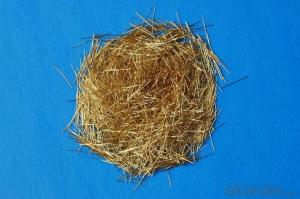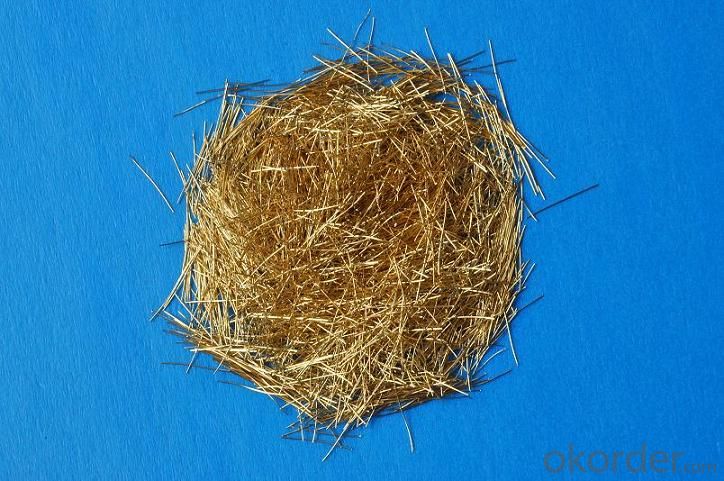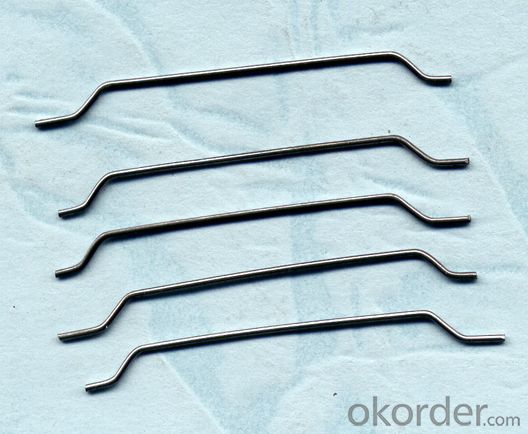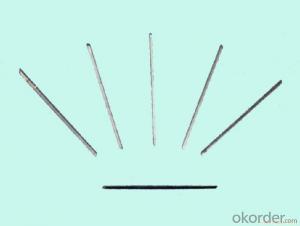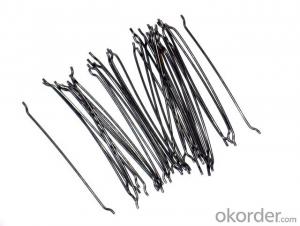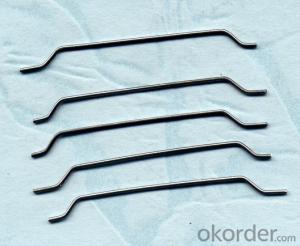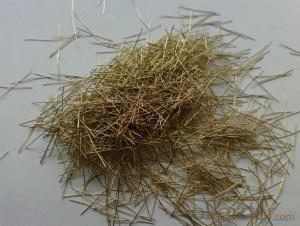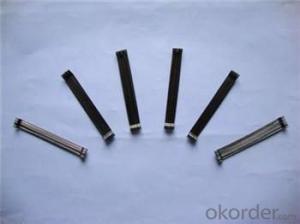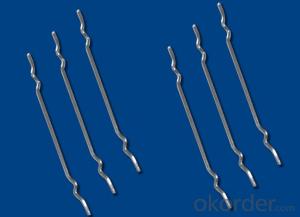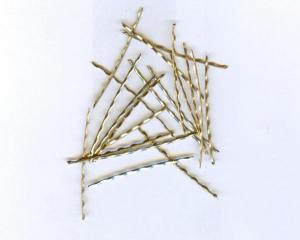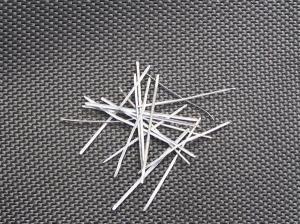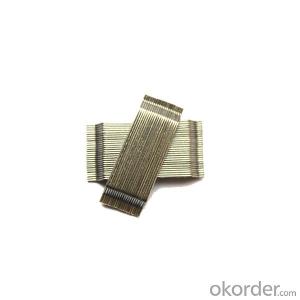Melt Extract Stainless Steel Fiber Loose Copper Plated Micro for Concrete
- Loading Port:
- Tianjin
- Payment Terms:
- TT OR LC
- Min Order Qty:
- 1000 kg
- Supply Capability:
- 30000 kg/month
OKorder Service Pledge
Quality Product, Order Online Tracking, Timely Delivery
OKorder Financial Service
Credit Rating, Credit Services, Credit Purchasing
You Might Also Like
Quick Details
Place of Origin: Jiangsu, China (Mainland)
Model Number: HT-MC
Material: Color Steel
certificated: ISO 9001
The products
Diameter: 0.4-1mm
Length: 30mm-60mm
Strength: 800-1200Mpa
Steel fiber specification can be made according to requirement
Specifications
| Product | Diameter | Length mm/in | Aspect Ratio | Type | Packing |
| G-6030 | 0.5 mm (0.0197 in) | 30 mm (1.1811 in) | 60 | Glued | 20 kg/Bag, or 1,000kg/ Bulk Bag |
| G-6535 | 0.55 mm (0.0217 in) | 35 mm (1.3780 in) | 65 | Glued | 20 kg/Bag, or 1,000kg/ Bulk Bag |
| G-6035 | 0.6 mm (0.0236 in) | 35 mm (1.3780 in) | 60 | Glued | 20 kg/Bag, or 1,000kg/ Bulk Bag |
| G-8060 | 0.75 mm (0.0295 in) | 60 mm (2.3622 in) | 80 | Glued | 20 kg/Bag, 50 bags/Pallet |
| G-6060 | 0.9 mm (0.0354 in) | 60 mm (2.3622 in) | 60 | Glued | 20 kg/Bag, 50 bags/Pallet |
| G-6030 | 0.5 mm (0.0197 in) | 30 mm (1.1811 in) | 60 | Loose | 20 kg/Bag, or 1,000kg/ Bulk Bag |
| G-6535 | 0.55 mm (0.0217 in) | 35 mm (1.3780 in) | 65 | Loose | 20 kg/Bag, or 1,000kg/ Bulk Bag |
| G-6035 | 0.6 mm (0.0236 in) | 35 mm (1.3780 in) | 60 | Loose | 20 kg/Bag, or 1,000kg/ Bulk Bag |
| G-8060 | 0.75 mm (0.0295 in) | 60 mm (2.3622 in) | 80 | Loose | 20 kg/Bag, 50 bags/Pallet |
| G-6060 | 0.9 mm (0.0354 in) | 60 mm (2.3622 in) | 60 | Loose | 20 kg/Bag, 50 bags/Pallet |
Picture
Steel fiber
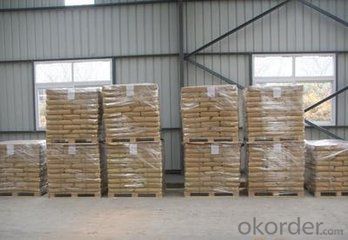
Improve mechanical performance of concrete
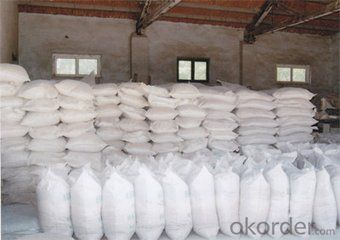
certificated: ISO 9001
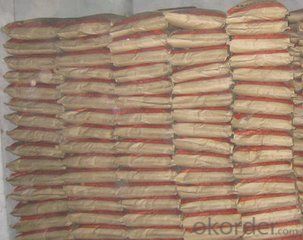
FAQ
Technical advantages of Daye steel fiber:
- Q: Can melt extract stainless steel fiber be used in decorative concrete applications?
- Yes, melt extract stainless steel fiber can be used in decorative concrete applications. This type of fiber is specifically designed to enhance the strength, durability, and aesthetic appeal of concrete surfaces. The stainless steel fibers are mixed into the concrete mixture, providing reinforcement and preventing cracking and shrinkage. Additionally, the stainless steel fibers can create a unique visual effect, adding a metallic shine or texture to the concrete surface. This makes it an ideal choice for decorative concrete applications where both strength and aesthetics are important, such as countertops, flooring, and architectural elements.
- Q: Can melt extract stainless steel fiber be used in underground mining applications?
- Yes, melt extract stainless steel fiber can be used in underground mining applications. It is commonly used for reinforcement purposes in concrete and other construction materials. Its high strength and resistance to corrosion make it suitable for the demanding conditions found in underground mining.
- Q: How does the size and shape of melt extract stainless steel fiber affect its performance?
- The size and shape of melt extract stainless steel fiber can significantly impact its performance. In terms of size, smaller fibers tend to have a larger surface area, which enhances their bonding capabilities with other materials and improves the overall strength and durability of the composite. On the other hand, larger fibers may offer better resistance to cracking and provide enhanced reinforcement. Regarding shape, the geometry of the fiber influences its ability to disperse stress and improve mechanical properties. For instance, straight fibers with a uniform shape tend to distribute loads more evenly, resulting in improved strength and stiffness. In contrast, crimped or irregularly shaped fibers can provide better interlocking with the matrix, leading to enhanced toughness and resistance against cracking. In summary, the size and shape of melt extract stainless steel fiber play a crucial role in determining its performance characteristics, including bond strength, durability, resistance to cracking, and mechanical properties.
- Q: How does the addition of melt extract stainless steel fiber impact the shrinkage of concrete?
- The addition of melt extract stainless steel fiber can have a significant impact on the shrinkage of concrete. Stainless steel fibers are added to concrete to enhance its strength, durability, and crack resistance. When these fibers are incorporated into the concrete mix, they provide reinforcement and reduce the overall shrinkage of the material. Concrete shrinkage is a natural phenomenon that occurs as the material dries and loses moisture. This shrinkage can lead to the development of cracks, which can compromise the integrity and longevity of the concrete structure. However, by adding melt extract stainless steel fibers, the shrinkage is mitigated, and the potential for cracks is greatly reduced. The stainless steel fibers work by creating a three-dimensional network within the concrete matrix. As the concrete shrinks, the fibers resist the tensile forces that develop, preventing the formation of cracks. The fibers act as reinforcement, distributing the stress throughout the material and improving its overall performance. Furthermore, the addition of melt extract stainless steel fibers can also enhance the post-cracking behavior of concrete. In the event that cracks do occur, the fibers provide bridging reinforcement across the cracks, preventing them from propagating further and improving the structural integrity of the concrete. Overall, the addition of melt extract stainless steel fibers to concrete results in a significant reduction in shrinkage and an improvement in crack resistance. This not only enhances the durability and longevity of the concrete structure but also ensures its ability to withstand external forces and environmental conditions.
- Q: How does melt extract stainless steel fiber improve the durability of tunnel linings?
- Melt extract stainless steel fiber improves the durability of tunnel linings by providing enhanced reinforcement and resistance to various forms of deterioration. When added to the concrete mixture used for tunnel linings, these stainless steel fibers act as micro-reinforcement, enhancing the overall strength and durability of the structure. One key benefit of melt extract stainless steel fiber is its ability to enhance the tensile strength of the concrete. Tunnels are subjected to various forces and stresses, including ground movement, vibrations, and water pressure. By reinforcing the concrete with stainless steel fibers, the tunnel linings become more resistant to cracking and spalling, which can compromise the structure's integrity. Moreover, the stainless steel fibers have a high resistance to corrosion, making them ideal for tunnel applications. Tunnels are often exposed to harsh environments, such as high humidity, chemical exposure, and saltwater intrusion. These conditions can cause the reinforcement within the concrete to corrode, leading to degradation and reduced durability. However, the corrosion-resistant properties of stainless steel fibers help prevent this deterioration, ensuring the tunnel linings remain structurally sound for an extended period. Additionally, melt extract stainless steel fibers improve the durability of tunnel linings by reducing the risk of fire damage. Tunnels can be vulnerable to fire incidents, which can significantly weaken the concrete and compromise the safety of the structure. The stainless steel fibers act as a reinforcement that can withstand high temperatures, preventing the concrete from rapidly losing its strength during a fire. This increased fire resistance enhances the overall durability and safety of the tunnel linings. In summary, melt extract stainless steel fiber enhances the durability of tunnel linings by improving tensile strength, corrosion resistance, and fire resistance. By reinforcing the concrete and protecting it from cracking, corrosion, and fire damage, these stainless steel fibers ensure that tunnel linings can withstand the various challenges they may encounter, ultimately extending their lifespan and enhancing the overall safety of the tunnels.
- Q: How is melt extract stainless steel fiber produced?
- Specialized manufacturing processes are used to produce melt extract stainless steel fiber. Initially, high-quality stainless steel alloy is melted in a furnace at extremely high temperatures. The molten steel is then forced through a spinneret, which is a fine nozzle with multiple small holes. As the molten steel passes through these holes, it solidifies and forms thin fibers. After the fibers are formed, they are rapidly cooled and solidified by passing them through a cooling chamber or a quench bath. This ensures that the fibers maintain their desired shape and strength. Once cooled, the fibers are gathered and further processed to eliminate any impurities or contaminants. Typically, the collected stainless steel fibers are cut into shorter lengths to enhance their usability in various applications. They can also undergo additional processing to modify their surface properties, such as applying a protective layer or different surface treatments. The melt extract process allows for the production of stainless steel fibers that have consistent dimensions and properties. These fibers possess excellent tensile strength, corrosion resistance, and high thermal conductivity, making them suitable for a broad range of applications. They are commonly utilized in industries such as concrete reinforcement, refractories, filtration systems, and as conductive additives.
- Q: Can melt extract stainless steel fiber be used in tunnel segment lining applications?
- Yes, melt extract stainless steel fiber can be used in tunnel segment lining applications. It offers excellent tensile strength and crack resistance, making it ideal for reinforcing the concrete used in tunnel segments. Additionally, its corrosion resistance properties ensure long-term durability in harsh underground environments.
- Q: Can melt extract stainless steel fiber be used in dam construction?
- Indeed, melt extract stainless steel fiber proves to be applicable in the field of dam construction. With its exceptional tensile strength, resistance to corrosion, and durability, stainless steel fiber is deemed suitable for an array of construction purposes, including dams. When integrated into concrete or other construction materials, the inclusion of stainless steel fibers elevates the overall robustness and longevity of the structure. In the realm of dam construction, where materials must endure the force exerted by water, the inclusion of stainless steel fibers substantially augments the structural integrity of the dam. Furthermore, stainless steel fibers effectively mitigate cracking, enhance resistance to fatigue and impact, thus establishing themselves as the optimal choice for dam construction, where materials must endure an assortment of stress-inducing factors.
- Q: Can melt extract stainless steel fiber be used in concrete bridge decks?
- Concrete bridge decks can indeed utilize melt extract stainless steel fiber. Stainless steel fibers are frequently employed as reinforcement in concrete structures, such as bridge decks, as they enhance the concrete's overall strength and durability. By doing so, they increase its resistance to cracking and improve its load-bearing capacity. Melt extract stainless steel fibers are particularly renowned for their exceptional tensile strength and corrosion resistance, which renders them an ideal selection for bridge decks that are exposed to severe environmental conditions. Moreover, these fibers aid in managing shrinkage and preventing crack formation, thereby improving the long-term performance and extending the service life of bridge decks. Consequently, melt extract stainless steel fiber represents a suitable and advantageous reinforcement alternative for concrete bridge decks.
- Q: How does melt extract stainless steel fiber affect the fatigue resistance of concrete?
- Melt extract stainless steel fiber improves the fatigue resistance of concrete by enhancing its ability to withstand repetitive loading and reducing the formation and propagation of cracks. The fibers act as reinforcement, increasing the tensile strength of the concrete and enhancing its overall durability. This helps to prevent fatigue failure and prolongs the service life of concrete structures.
Send your message to us
Melt Extract Stainless Steel Fiber Loose Copper Plated Micro for Concrete
- Loading Port:
- Tianjin
- Payment Terms:
- TT OR LC
- Min Order Qty:
- 1000 kg
- Supply Capability:
- 30000 kg/month
OKorder Service Pledge
Quality Product, Order Online Tracking, Timely Delivery
OKorder Financial Service
Credit Rating, Credit Services, Credit Purchasing
Similar products
Hot products
Hot Searches
Related keywords
